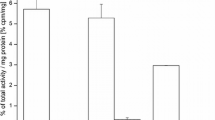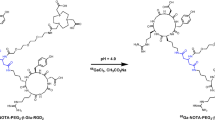Abstract
Purpose
In vivo imaging of αvβ3 has important diagnostic and therapeutic applications. 18F-Galacto-arginine–glycine–aspartic acid (RGD) has been developed for positron emission tomography (PET) imaging of integrin αvβ3 expression and is now being tested on humans. Dimerization and multimerization of cyclic RGD peptides have been reported to improve the integrin αvβ3-binding affinity due to the polyvalency effect. Here, we compared a number of new dimeric RGD peptide tracers with the clinically used 18F-galacto-RGD.
Procedures
RGD monomers and dimers were coupled with galacto or PEG3 linkers, and labeled with 18F using 4-nitrophenyl 2-18F-fluoropropionate (18F-NFP) or N-succinimidyl 4-18F-fluorobenzoate as a prosthetic group. The newly developed tracers were evaluated by cell-based receptor-binding assay, biodistribution, and small-animal PET studies in a subcutaneous U87MG glioblastoma xenograft model.
Results
Starting with 18F-F−, the total reaction time for 18F-FP-SRGD2 and 18F-FP-PRGD2 is about 120 min. The decay-corrected radiochemical yields for 18F-FP-SRGD2 and 18F-FP-PRGD2 are 52 ± 9% and 80 ± 7% calculated from 18F-NFP. Noninvasive small-animal PET and direct tissue sampling experiments demonstrated that the dimeric RGD peptides had significantly higher tumor uptake as compared to 18F-galacto-RGD.
Conclusion
Dimeric RGD peptide tracers with relatively high tumor integrin-specific accumulation and favorable in vivo kinetics may have the potential to be translated into clinic for integrin αvβ3 imaging.





Similar content being viewed by others
References
Bishop GG, McPherson JA, Sanders JM, Hesselbacher SE, Feldman MJ, McNamara CA, et al (2001) Selective αvβ3-receptor blockade reduces macrophage infiltration and restenosis after balloon angioplasty in the atherosclerotic rabbit. Circulation 103:1906–1911
Storgard CM, Stupack DG, Jonczyk A, Goodman SL, Fox RI, Cheresh DA (1999) Decreased angiogenesis and arthritic disease in rabbits treated with an αvβ3 antagonist. J Clin Invest 103:47–54
Teitelbaum SL (2000) Bone resorption by osteoclasts. Science 289:1504–1508
Albelda SM, Mette SA, Elder DE, Stewart R, Damjanovich L, Herlyn M, et al (1990) Integrin distribution in malignant melanoma: association of the beta 3 subunit with tumor progression. Cancer Res 50:6757–6764
Bello L, Francolini M, Marthyn P, Zhang J, Carroll RS, Nikas DC, et al (2001) αvβ3 and αvβ5 integrin expression in glioma periphery. Neurosurgery 49:380–389
Brooks PC, Stromblad S, Klemke R, Visscher D, Sarkar FH, Cheresh DA (1995) Anti integrin αvβ3 blocks human breast cancer growth and angiogenesis in human skin. J Clin Invest 96:1815–1822
Beer AJ, Schwaiger M (2008) Imaging of integrin αvβ3 expression. Cancer Metastasis Rev 27:631–644
Cai W, Niu G, Chen X (2008) Imaging of integrins as biomarkers for tumor angiogenesis. Curr Pharm Des 14:2943–2973
Dijkgraaf I, Beer AJ, Wester HJ (2009) Application of RGD-containing peptides as imaging probes for αvβ3 expression. Front Biosci 14:887–899
Cai W, Chen X (2008) Multimodality molecular imaging of tumor angiogenesis. J Nucl Med 49 Suppl 2:113S–128S
Chen X (2006) Multimodality imaging of tumor integrin αvβ3 expression. Mini Rev Med Chem 6:227–234
Haubner R, Wester HJ, Weber WA, Mang C, Ziegler SI, Goodman SL, et al (2001) Noninvasive imaging of αvβ3 integrin expression using 18F-labeled RGD-containing glycopeptide and positron emission tomography. Cancer Res 61:1781–1785
Beer AJ, Haubner R, Sarbia M, Goebel M, Luderschmidt S, Grosu AL, et al (2006) Positron emission tomography using [18F]Galacto-RGD identifies the level of integrin αvβ3 expression in man. Clin Cancer Res 12:3942–3949
Beer AJ, Haubner R, Wolf I, Goebel M, Luderschmidt S, Niemeyer M, et al (2006) PET-based human dosimetry of 18F-galacto-RGD, a new radiotracer for imaging αvβ3 expression. J Nucl Med 47:763–769
Beer AJ, Niemeyer M, Carlsen J, Sarbia M, Nahrig J, Watzlowik P, et al (2008) Patterns of αvβ3 expression in primary and metastatic human breast cancer as shown by 18F-Galacto-RGD PET. J Nucl Med 49:255–259
Picchio M, Beck R, Haubner R, Seidl S, Machulla HJ, Johnson TD, et al (2008) Intratumoral spatial distribution of hypoxia and angiogenesis assessed by 18F-FAZA and 125I-Gluco-RGD autoradiography. J Nucl Med 49:597–605
Beer AJ, Grosu AL, Carlsen J, Kolk A, Sarbia M, Stangier I, et al (2007) [18F]galacto-RGD positron emission tomography for imaging of alphavbeta3 expression on the neovasculature in patients with squamous cell carcinoma of the head and neck. Clin Cancer Res 13:6610–6616
Beer AJ, Haubner R, Goebel M, Luderschmidt S, Spilker ME, Wester HJ, et al (2005) Biodistribution and pharmacokinetics of the αvβ3-selective tracer 18F-galacto-RGD in cancer patients. J Nucl Med 46:1333–1341
Beer AJ, Lorenzen S, Metz S, Herrmann K, Watzlowik P, Wester HJ, et al (2008) Comparison of integrin αvβ3 expression and glucose metabolism in primary and metastatic lesions in cancer patients: a PET study using 18F-galacto-RGD and 18F-FDG. J Nucl Med 49:22–29
Haubner R, Weber WA, Beer AJ, Vabuliene E, Reim D, Sarbia M, et al (2005) Noninvasive visualization of the activated αvβ3 integrin in cancer patients by positron emission tomography and [18F]Galacto-RGD. PLoS Med 2:e70
Kreiner M, Li Z, Beattie J, Kelly SM, Mardon HJ, van der Walle CF (2008) Self-assembling multimeric integrin α5β1 ligands for cell attachment and spreading. Protein Eng Des Sel 21:553–560
Zhang X, Xiong Z, Wu Y, Cai W, Tseng JR, Gambhir SS, et al (2008) Quantitative PET imaging of tumor integrin αvβ3 expression with 18F-FRGD2. J Nucl Med 47:113–121
Chen X, Liu S, Hou Y, Tohme M, Park R, Bading JR, et al (2004) MicroPET imaging of breast cancer αv-integrin expression with 64Cu-labeled dimeric RGD peptides. Mol Imaging Biol 6:350–359
Mammen M, Chio S-K, Whitesides GM (1998). Polyvalent interactions in biological systems: implications for design and use of multivalent ligands and inhibitors. Angew Chem Int Ed Engl 37:2755–2794
Li ZB, Cai W, Cao Q, Chen K, Wu Z, He L, et al (2007) 64Cu-labeled tetrameric and octameric RGD peptides for small-animal PET of tumor αvβ3 integrin expression. J Nucl Med 48:1162–1171
Wu Z, Li ZB, Cai W, He L, Chin FT, Li F, et al (2007) 18F-labeled mini-PEG spacered RGD dimer (18F-FPRGD2): synthesis and microPET imaging of αvβ3 integrin expression. Eur J Nucl Med Mol Imaging 34:1823–1831
Wu Z, Li ZB, Chen K, Cai W, He L, Chin FT, et al (2007) microPET of tumor integrin αvβ3 expression using 18F-labeled PEGylated tetrameric RGD peptide (18F-FPRGD4). J Nucl Med 48:1536–1544
Poethko T, Schottelius M, Thumshirn G, Hersel U, Herz M, Henriksen G, et al (2004) Two-step methodology for high-yield routine radiohalogenation of peptides: 18F-labeled RGD and octreotide analogs. J Nucl Med 45:892–902
Thumshirn G, Hersel U, Goodman SL, Kessler H (2003) Multimeric cyclic RGD peptides as potential tools for tumor targeting: solid-phase peptide synthesis and chemoselective oxime ligation. Chemistry 9:2717–2725
Haubner R, Kuhnast B, Mang C, Weber WA, Kessler H, Wester HJ, et al (2004) [18F]Galacto-RGD: synthesis, radiolabeling, metabolic stability, and radiation dose estimates. Bioconjug Chem 15:61–69
Cai W, Zhang X, Wu Y, Chen X (2006) A thiol-reactive 18F-labeling agent, N-[2-(4-18F-fluorobenzamido)ethyl]maleimide, and synthesis of RGD peptide-based tracer for PET imaging of αvβ3 integrin expression. J Nucl Med 47:1172–1180
Wu Y, Zhang X, Xiong Z, Cheng Z, Fisher DR, Liu S, et al (2005) microPET imaging of glioma integrin αvβ3 expression using 64Cu-labeled tetrameric RGD peptide. J Nucl Med 46:1707–1718
Liu Z, Liu S, Wang F, Chen X (2009) Noninvasive imaging of tumor integrin expression using 18F-labeled RGD dimer peptide with PEG4 linkers. Eur J Nucl Med Mol Imaging 36:1296–1307
Dijkgraaf I, Kruijtzer JA, Liu S, Soede AC, Oyen WJ, Corstens FH, et al (2007) Improved targeting of the αvβ3 integrin by multimerisation of RGD peptides. Eur J Nucl Med Mol Imaging 34:267–273
Janssen ML, Oyen WJ, Dijkgraaf I, Massuger LF, Frielink C, Edwards DS, et al (2002) Tumor targeting with radiolabeled αvβ3 integrin binding peptides in a nude mouse model. Cancer Res 62:6146–6151
Haubner R, Finsinger D, Kessler H (1997) Stereoisomeric peptide libraries and peptidomimetics for designing selective inhibitors of the αvβ3 integrin for a new cancer therapy. Angew Chem Int Ed Engl 36:1374–1389
Haubner R, Wester HJ, Reuning U, Senekowitsch-Schmidtke R, Diefenbach B, Kessler H, et al (1999) Radiolabeled αvβ3 integrin antagonists: a new class of tracers for tumor targeting. J Nucl Med 40:1061–1071
Harris JM, Martin NE, Modi M (2001) Pegylation: a novel process for modifying pharmacokinetics. Clin Pharmacokinet 40:539–551
Chen X, Park R, Shahinian AH, Bading JR, Conti PS (2004) Pharmacokinetics and tumor retention of 125I-labeled RGD peptide are improved by PEGylation. Nucl Med Biol 31:11–19
Schipper ML, Iyer G, Koh AL, Cheng Z, Ebenstein Y, Aharoni A, et al (2008) Particle size, surface coating, and PEGylation influence the biodistribution of quantum dots in living mice. Small 5:126–134
Boturyn D, Coll JL, Garanger E, Favrot MC, Dumy P (2004) Template assembled cyclopeptides as multimeric system for integrin targeting and endocytosis. J Am Chem Soc 126:5730–5739
Li ZB, Chen K, Chen X (2008) 68Ga-labeled multimeric RGD peptides for microPET imaging of integrin αvβ3 expression. Eur J Nucl Med Mol Imaging 35:1100–1108
Acknowledgment
This work was supported, in part, by the National Cancer Institute (R01 120188, R01 CA119053, R21 CA121842, P50 CA114747, U54 CA119367, and R24 CA93862). We thank the cyclotron team at Stanford University for 18F-F− production.
Author information
Authors and Affiliations
Corresponding author
Additional information
Shuanglong Liu and Zhaofei Liu contributed equally to this work.
Rights and permissions
About this article
Cite this article
Liu, S., Liu, Z., Chen, K. et al. 18F-Labeled Galacto and PEGylated RGD Dimers for PET Imaging of αvβ3 Integrin Expression. Mol Imaging Biol 12, 530–538 (2010). https://doi.org/10.1007/s11307-009-0284-2
Received:
Revised:
Accepted:
Published:
Issue Date:
DOI: https://doi.org/10.1007/s11307-009-0284-2




